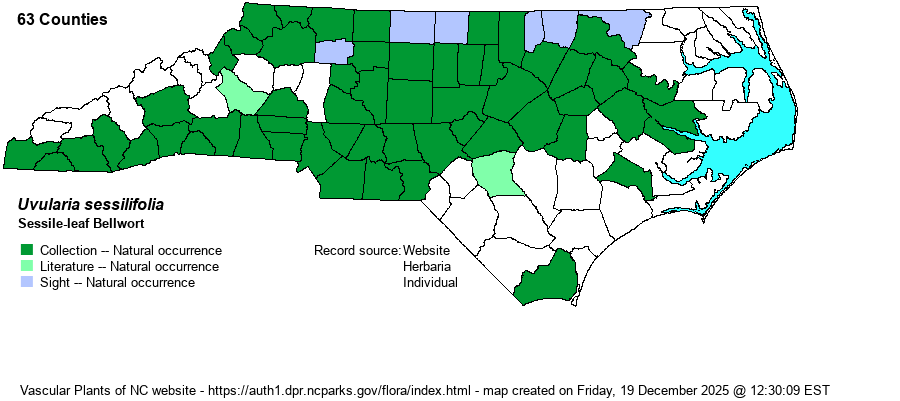| Author | L. | |
| Distribution | Throughout the Piedmont, and most of the Mountains. Also present throughout the northwestern Coastal Plain. Scarce in the eastern and southern portions of the Coastal Plain, and likely absent in far eastern counties. Oddly, there are many iNaturalist photos from the Mountains -- in counties along the TN state line --accepted as this species, when in fact they are of U. puberula! (One cannot thus accept confirmed records there at face value, but there are also many photos of various species clearly correct yet still awaiting two reviewers to accept.)
This is an Eastern species, occurring over a wide range from southern Canada south to the FL Panhandle and extreme eastern TX. | |
| Abundance | Common in the Piedmont and adjacent parts of the northwestern Coastal Plain. Uncommon to infrequent in the Mountains, mainly in the lower elevations. Very rare to absent east of Northampton and Beaufort counties, and in the southern third of the Coastal Plain. | |
| Habitat | This is the only bellwort that prefers bottomland forests as opposed to forested slopes. It may grow on slopes, but mainly where rich or moist and not steep. Though it does favor bottomlands and wooded streamsides, it is not normally found in flooded swamps or in wet forested sites--thus it avoids long periods of inundation. |
| Phenology | Blooms from late March to early May, and fruits from August to October. Note that this species flowers rather infrequently, for some odd reason. You might see hundreds or thousands of plants without finding any in bloom during the peak of the spring season. | |
| Identification | This is a small "lily", as is U. puberula. Like that species, it grows only to a height of about 6 inches, but it contains a number of thin, flexible, and bright yellow-green leaves instead of dark green, thick, and shiny as in the other species. These leaves average about 2 inches long and 1 inch wide, and most are held horizontally. The pale yellow flowers dangle from the several branches, and are about 2/3-3/4-inch long. As mentioned above, for some reason the species sends up many more sterile plants than fertile ones, and the species is almost always found in colonies, of at times thousands of plants. In addition, the species tends to have a zigzag stem, and/or zigzag branches, rather than a straight one in the three other bellwort species. This can be an important character, as so few plants seem to bloom, and thus you may need to use the colonial growth form and the zigzag stems and branches to identify the species. Don't confuse this species with a grass; plants growing in large patches in a bottomland forest, without obvious flowers, might look a bit like a witchgrass (Dichanthelium, etc.) or might simply be passed over by a casual observer as not being a lily. | |
| Taxonomic Comments | None
| |
| Other Common Name(s) | Sessile Bellwort, Spreading Bellwort, Straw-lily, Merrybells, Wild-oats | |
| State Rank | S4 [S5] | |
| Global Rank | G5 | |
| State Status | | |
| US Status | | |
| USACE-agcp | FAC link |
| USACE-emp | FAC link |

